New Downtown Rain Garden Reduces Sidewalk Width Too Much
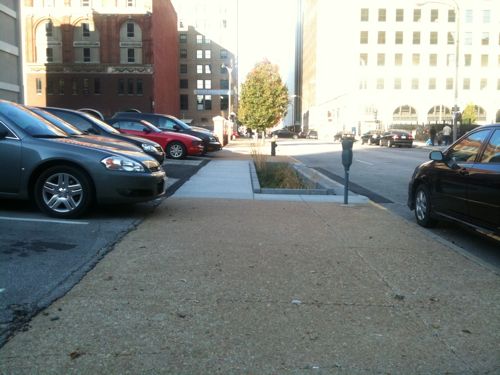
Here is an addition to downtown you may have missed, here was the press release:
ST. LOUIS, November 10, 2010 – The Downtown Community Improvement District (CID) has installed its first demonstration Rain Garden at the corner of 11th and Pines Streets. One of the CID’s goals for this project was to catalyze a trend toward more sustainable streetscapes in the city. The 11th Street pilot project employs a new segmental wall and curb system, called Freno, that offers a cost-effective, modular method of building an urban rain garden.
This rain garden was designed to capture rain water from the gutter and adjacent parking lot, prior to reaching the sewer system. This sustainable landscape does not require watering and gives back to the environment by specifically designated plants and soil mix that filter out 80-90% of the pollutants from car fluid and road treatment chemicals.
Rain gardens have been designated in the downtown St. Louis streetscape plan and they are gaining popularity in downtowns across the nation and abroad. With this in mind, the need for sustainable landscapes in downtown is becoming more and more important.
The materials and labor that went into the construction of this rain garden has been 100% donated by the City of St. Louis Department of Streets, HOK, Midwest Products, St. Louis Composting, Forrest Keeling Nursery, and the Downtown CID.
This Downtown Next priority is brought to you by the Downtown CID – dedicated to a cleaner, safer, more vibrant and greener Downtown. Downtown St. Louis is a regional leader in sustainable practices.
I like rain gardens, they do a great job of reducing water runoff.
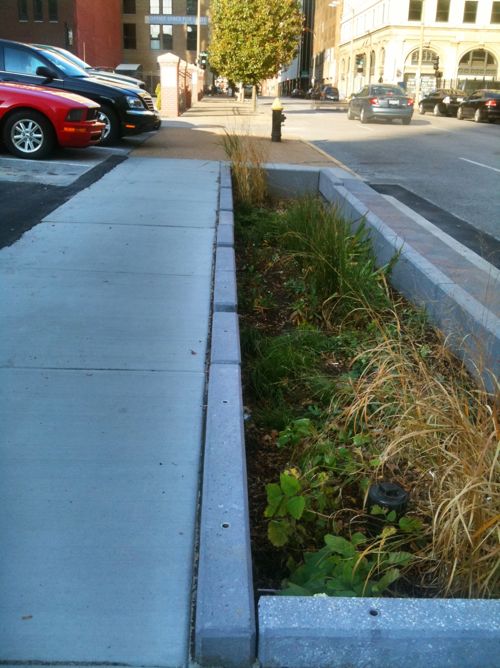
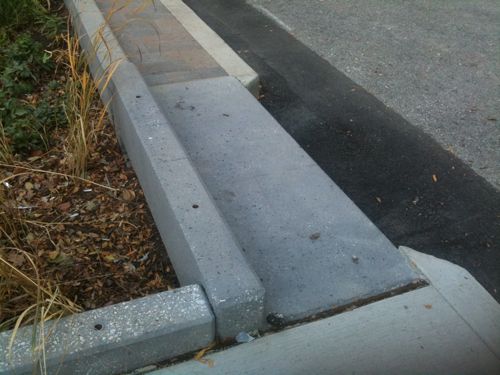
But I also like sidewalk space and this new rain garden consumes way too much of the width of the sidewalk. Â Eliminating a driveway into the adjacent parking lot is a very good thing but with the reduced width of the sidewalk I’m concerned about cars parking too far forward.
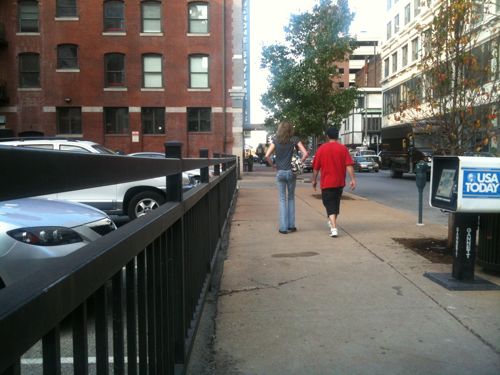
Ideally there would be fencing to prevent cars from parking so their front ends don’t further squeeze the sidewalk space. Â Simple wheel stops in the parking lot would solve the problem on the cheap. Â The rain gardens on 9th & Market (Citygarden) extend out from the curb line into what is normally the parking lane. Â Here, on 11th, parking is not permitted next to the rain garden so the street width is excessive for the two travel lanes. Â The curb to curb for the roadway is too wide but the sidewalk width was cut in half. Typical.
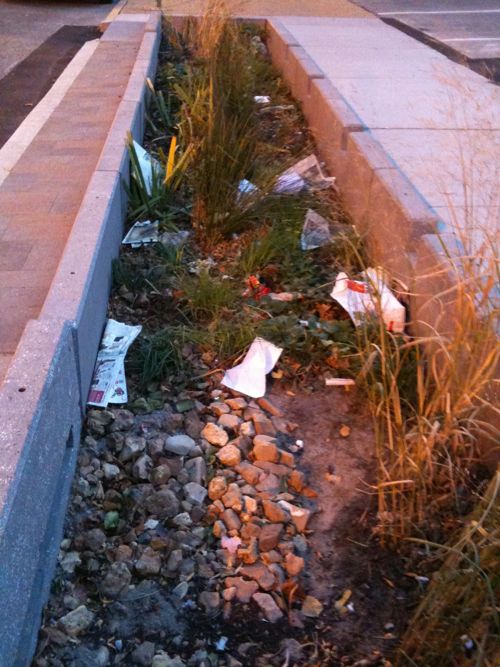
The problem of trash will be ongoing. Â Good intentions, poor execution.
– Steve Patterson
With the indoor smoking ban coming next year, we're going to need a lot more of these communal ashtrays . . . but seriously, this is a classic example of conflicting priorities. Do you/we want wide, urban sidewalks in the CBD, or do you/we want to bring back the prairie/suburbs? It doesn't matter if it's a surface parking lot or a flat-roofed loft, ANY downtown area is marked by a lot of impermeable surfaces, a direct result of maximizing density. Rain gardens are highly dependent on soil permeability – creating a low spot doesn't guarantee that much water will actually return to the aquifer, but it does guarantee that both trash and silt will find its way there. I see good intentions and idealism, but I don't see much of a real-world future for this specific concept . . .
Reducing the volume of water in our old sewer system has nothing to do with trying to recreate prairie.
The issue is, St. Louis took the easy way out by installing a rain garden that fails on two critical counts: 1) It isn't in a public enough space to garner any attention from pedestrians; 2) It's not interesting enough to be appealing to those that do walk by the space. I am first on board when it comes to rain gardens and sustainable solutions, and I think introducing some 'prairie/suburbs' to all urban districts will mean better cities – I think we have to shift how we define city space, and what that city space achieves. If I had done this rain garden, it would have been in a space with greater foot traffic, and it wouldn't have been so linear. Here's a great example from KC.
http://www.rainkc.com/index.cfm/fuseaction/portfolio.detail/recID/25/index.htm
Agreed! That KC example is excellent, I will check it out next month when I'm there. Like Citygarden, it reduces the total street width while maintaing the sidewalk width.
I agree – much better! Plus it takes away from “unused” steet, not from the existing pedestrian areas.
It also serves as a nice end cap to a row of on-street parking. The road surface width is visually reduced which calms traffic improving the experience for pedestrians on the adjacent sidewalk and cyclists on the road.
Rain Garden – another fancy word for ditch or swamp? A mini-me version of a detention or retention pond? I get the theory, especially in places like Florida, where the soil actually drains quickly, but I'm not so sure around here. The example you're showing seems to have limited capacity, especially if it's intended for the surface parking lot.
Perhaps a poor location for a system that requires maintenance. The rain garden and effective runoff management would be better served in areas with maintenance commitments from adjacent residents or businesses.
Part of the point of a “rain garden” is that it doesn’t need maintenance. Putting in climate appropriate, hearty perennials should require only the rainwater. If your point is about the trash, then that would be solved by putting it in a more visible location, which is what they should have done anyway.
Rain gardens do need maintenance. Otherwise they clog and don’t drain. To JZ, yes, rain gardens in St. Louis. MSD requires them more and more. It’s one method of reducing storm water surges into our undercapacity sewer system. When you can get up to 4-5 inches of rain in a STL thunderstorm (no different than Florida), you get flooding. Ask people in North City. MSD is trying to do whatever it can to mitigate the problem. Eventually, we will all pay higher sewer bills to increase the capacity of the system.
Rain garden? I hope we don't see this spreading further reducing sidewalk space. Hey STL, if you want to reduce storm water runoff then get some green roofs and stop building surface parking lots.
Hopefully MSD is able to get storm water fees back given a judge threw them out due to the Hancock amendment. They can provide an indirect incentive promoting green roofs.
Part of the point of a “rain garden” is that it doesn’t need maintenance. Â Putting in climate appropriate, hearty perennials should require only the rainwater. Â If your point is about the trash, then that would be solved by putting it in a more visible location, which is what they should have done anyway. Â Â
Rain gardens do need maintenance. Otherwise they clog and don’t drain. To JZ, yes, rain gardens in St. Louis. MSD requires them more and more. It’s one method of reducing storm water surges into our undercapacity sewer system.  When you can get up to 4-5 inches of rain in a STL thunderstorm (no different than Florida), you get flooding. Ask people in North City. MSD is trying to do whatever it can to mitigate the problem. Eventually, we will all pay higher sewer bills to increase the capacity of the system.